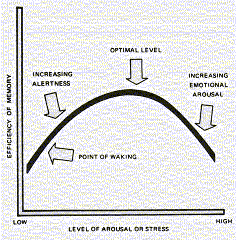Note: This site is moving to KnowledgeJump.com. Please reset your bookmark.
Yerkes-Dodson law — Arousal
Arousal is a major aspect of many learning theories and is closely related to other concepts, such as anxiety, attention, agitation, stress, and motivation. The arousal level can be thought of as how much capacity you have available to work with. One finding with respect to arousal is the Yerkes-Dodson law (first observed by Robert M. Yerkes and John D. Dodson (1908). It predicts an inverted U-shaped function between arousal and performance. A certain amount of arousal can be a motivator toward change (with change in this discussion being learning). Too much or too little change will certainly work against the learner. You want some mid-level of arousal to provide the motivation to change (learn). Too little arousal has an inert affect on the learner, while too much has a hyperactive affect. Also, there are optimal levels of arousal for each task to be learned. The optimal level of arousal is normally:
- lower for more difficult or cognitive tasks (the learners need to concentrate on the material)
- higher for tasks requiring endurance and persistence (the learners need more motivation)
For more information, see Arousal and Performance.
Reference
Yerkes, R. M. & Dodson, J. D. (1908). The Relation of Strength of Stimulus to Rapidity of Habit-Formation. Journal of Comparative Neurology and Psychology, 18, 459-482.



